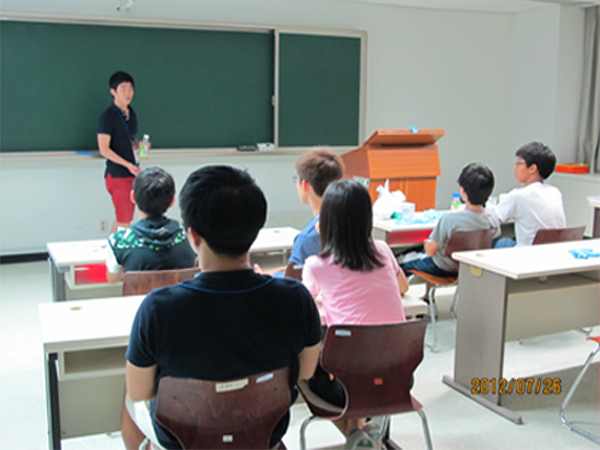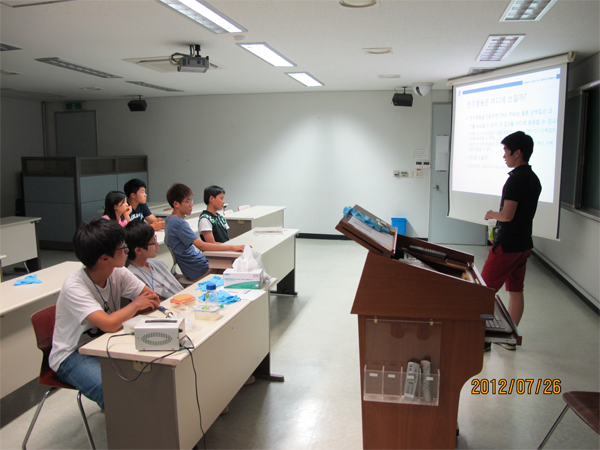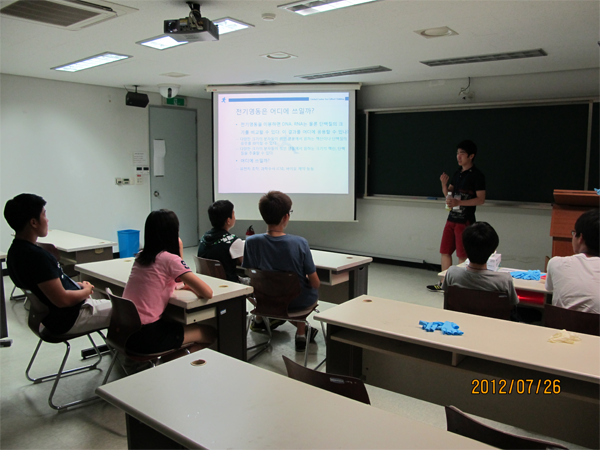We all know that the world economy largely rely on petroleum and it is now in a huge crisis due to its depletion. Many ideas and technologies have been suggested to replace the petroleum based system but they all have limitations. However, we, KAIST iGEM 2012 Team suggest a totally new but effective idea to substitute the conventional system. We try to produce an E. coli which can survive on CO
2 and H
2 as well as produce biomass, especially acetyl CoA. In this system, the substitute of petroleum system can resolve both problems of energy and material. In addition, it may relieve the global warming by consuming greenhouse gas.
We are working on a project which may have great effects to our future. We believe it to be helpful and useful for human civilization but we still have to consider both the bright and dark sides of it. To do so, we have or have planned to introduce the concept of our project and synthetic biology and then share ideas about them with the public. Since synthetic biology is not very familiar to the public in Korea, we prepared some lectures for this. As people of different ages would have different thoughts and thus give various opinions about synthetic biology, we divided the public into three groups; kids (middle school students), juveniles (high school students), and adults. We made contact to most prosperous and leading people of each group and have talked about synthetic biology and the project of KAIST iGEM 2012.
- Talk with middle school students
In order to distribute our concept of generating energy and biomass through engineered E. coli, we tried to reach several groups of people. Among several attempts, we could first contact an academy for gifted children in KAIST called ‘Global Center for Gifted Children’ (GC2). Although we got several other offers, we decided to introduce our project, synthetic biology, and iGEM to middle school kids since they have the biggest potential to be the leading power in the future which synthetic biology will make. They planned to hold a science camp this summer and one of our members, Jihwan participated in the camp as a biology teacher. For the camp, we prepared three lectures and activities related to synthetic biology and iGEM; DNA structure and its manipulation, gel electrophoresis and its application, and concepts and applications of synthetic biology. The camp was held for four days from July 24th to July 27th and 46 middle school students of Daejeon city who were selected to the academy had participated. Our team has participated in biology session with the lectures we prepared and Jihwan as a main instructor. Because synthetic biology is quite a new field of study, kids first learned about its concepts, which is mainly about ‘Biobricks’, and iGEM competition as the biggest global event about synthetic biology. In the lecture of DNA, we explained the structures of DNA and genes and how we can manipulate the genetic sequences to yield genetically modified products. For the case of gel electrophoresis, we prepared a simple experiment to actually run DNA samples in agarose gel and figure out the size of DNA samples. Even though there are many other crucial experiments used in synthetic biology, we thought gel electrophoresis to be the most necessary and easiest experiment for middle school students to have a look at what synthetic biology actually does.
- Talk with high school students
Next, we have scheduled to give lectures to high school students. In the case of middle school kids, we thought that they would live the society affected by synthetic biology, enjoying the beauty of it. However, for high school students, we viewed them as our company to lead the breakthrough of synthetic biology together with us. Thus, we contacted ‘Seoul Science High School’ and will give a lecture to the students who major in biology in that school on August 20th. For this time, Jihwan and Namil will be the lecturers and the contents and difficulty of the lecture will differ from those for middle school students.
For adults, who are actually running the society right now, we prepared something different from the lectures for kids or juveniles. In this case, we participated in a global conference held in KAIST, ICISTS-KAIST 2012, and introduced about synthetic biology and iGEM project. In the conference, we, lecturers, and delegates shared each other’s thoughts over synthetic biology and iGEM project. We believed there would be numerous global leaders who have actual powers to change the world, thus we viewed the conference as a chance for us to gain support from those powerful figures. To be specific, we participated in the talk about Appropriate Technology, which seemed to be related to our project and debated about the feasibility and sustainability of our project. Indeed, many of the people we met in the conference told us their opinions about synthetic biology and its role in society as well as its potential to improve human civilization. However, considering appropriate technology, synthetic biology and our team project have several obstacles to overcome. According to lecturers, most highly developed technologies have been enjoyed by 10% of global population who has 90% of global wealth. Since this situation is not sustainable at all, scientists and engineers started to focus on technologies for the other 90% of population. In other words, they started to figure out which technology generally benefits people, which will in turn improve the social status of unprivileged people and facilitate underdeveloped countries to be developed. The problem we are facing now is that synthetic biology is expensive and difficult to be understood by those who don’t major in biology, thus it cannot immediately benefit every single person in the world. Since the ultimate goal of iGEM is to generate Biobrick parts library and modify or sometimes synthesize organisms which will benefit human race in long term, we believe adopting the notion of appropriate technology to iGEM and synthetic biology would further improve this goal.





 "
"













